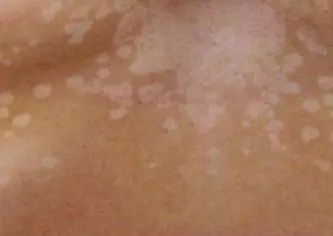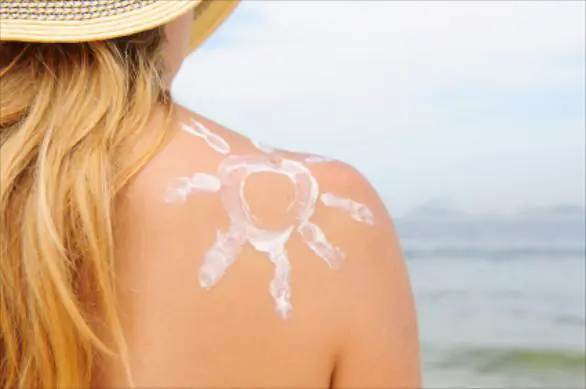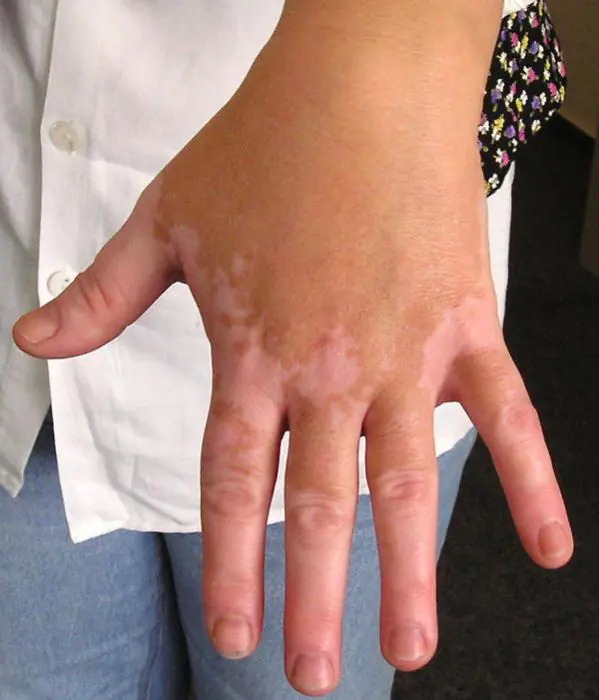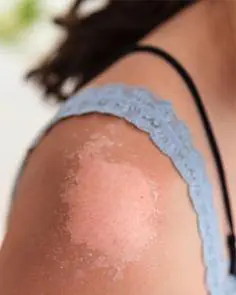When we go on vacation to the sea, we want to return from there with an even and golden tan. Unfortunately, sometimes the result is completely unpredictable. Even after using special sunscreens, we get dark or white spots on our skin after sunbathing. A photo that shows the picture of the disease is shown below.

This condition does not add attractiveness to the skin. Of course, spots can be covered up, and in some cases, treatment may be necessary. But before taking any measures, you need to find out what is the cause of this unpleasant phenomenon.
Causes
Tanning occurs when the skin is exposed to ultraviolet rays. When sunbathing on the beach, you need to take precautions to avoid unpleasant consequences in the form of burns, pigmentation, and spots on the body. There are a number of reasons why white spots may appear on the skin after sunbathing. These include liver problems, hormonal disorders, kidney and adrenal diseases, decreased immunity, gastrointestinal problems, stress, deficiency of vitamins and microelements, and heredity.
Sunburn
This phenomenon is familiar to many. Prolonged exposure to the scorching rays of the sun leads to burns, which are manifested by redness of the skin, in severe cases it becomes covered with blisters. Skin burns may be accompanied by headache, nausea, and weakness. After the blisters disappear, spots remain on the skin.

Skin pigmentation
The cause of uneven tanning may be genetic characteristics that lead to the fact that melanin production does not occur in some areas of the skin, which is why white spots appear on the skin after tanning. This condition is called idiopathic guttate hypomelanosis. If you have this condition, do not forget that exposure to the sun can make the spots even more noticeable. This condition, unfortunately, has no cure.
Taking medications
The use of certain medications leads to increased sensitivity and vulnerability of the skin to ultraviolet radiation. The most common medications that cause changes in the skin are birth control pills and antibiotics. These medications interfere with your tan's uniformity, causing your tan to appear patchy. This phenomenon is called photosensitivity of the skin. If you cannot avoid exposure to the sun, you should notify your doctor about this and consult about taking certain medications that may have side effects.

Fungus
White spots on the skin after sunbathing can be the result of fungal diseases. Such ailments lead to the fact that ultraviolet rays do not reach some areas of the skin, and the tan turns out to be uneven. The development of non-contagious forms of the fungus is caused by increased sweating with constant exposure to heat, as a result of which white spots appear on the skin after sunbathing. A specialist will tell you how to treat this disease. In general, the use of special ointments or creams, as well as tablets or antifungal drugs prescribed by a doctor, is recommended.
Vitiligo
With this disease, white spots mainly cover the hands and face. This condition is a warning from the body about serious problems in the functioning of any organs. Even poisoning or disorders of the nervous system can provoke the development of the disease. Only a doctor can establish an accurate diagnosis and prescribe treatment, but, unfortunately, a medicine has not yet been found that can completely eliminate the disease. The condition can be improved with light wave therapy, depigmentation or tattooing.

Poikiloderma Siwatt
A sign of this condition, which is not considered a disease, are white spots on the skin after sunbathing. Treatment consists only of using special tanning products. The spots appear only in the neck and chest area. Most often found in people with fair skin. Sunbathing is not recommended until the skin is cleared.
Hormonal imbalances
Problems with the thyroid gland can cause spots on the body. Therefore, prolonged exposure to the sun is contraindicated for women during pregnancy and menstrual periods.
Excessive pressure
This is the most common and harmless cause of skin spotting. Lying down reduces blood flow to areas of the skin that are pressed down. While sunbathing in a solarium, you can find such marks in the pelvic area, on the shoulder blades or elbows. The solution to the problem is quite simple - when sunbathing, you need to change your position more often.
White spots after sunbathing in children
White spots on the skin after sunbathing in a child can be a result of sunburn or as a manifestation of tinea versicolor and vitiligo. The causes of vitiligo in a child may be intestinal dysbiosis, dysfunction of the pancreas, or helminthic infestation. To eliminate the causes of the disease, it is necessary to carry out specific diagnostics followed by treatment.
In addition, such a symptom may be a sign of a rare pathology - hypomelanosis. The disease occurs after severe infectious diseases, which result in damage to the nervous system.
Treatment
In any case, it is necessary to consult a doctor to determine the cause of this phenomenon and prescribe appropriate treatment. Special medications can help with ringworm, but only a specialist should prescribe them. Consultation with a doctor is also necessary for vitiligo. This condition requires a complete examination of the body, as it indicates the presence of problems in its functioning.

If excessive sweating is the cause of your uneven tan, a good anti-sweat product will help. The appearance of white spots while taking medications is an indication for changing the drug. Or you can start sunbathing after the course of treatment ends.
Precautionary measures
White spots on the skin after sunbathing are most often not a sign of illness, but arise from non-compliance with the rules for being in the sun.
You can sunbathe in the morning from 9 to 11 o'clock or in the evening from 16-17 o'clock. This is the safest time to tan.
Don't forget that your skin should get used to the sun's rays gradually. Don't try to get a tan on the first day of your vacation, as this can result in burns and dehydration. Be sure to use protective equipment when tanning.
To avoid stains while sunbathing, do not use decorative cosmetics. The presence of preservatives and other elements in its composition can cause an uneven tan.
How to achieve an even tan?
If spotty skin is not the result of any disease, you can try to make your tan more uniform using simple methods.
When taking a bath, use a stiff washcloth to exfoliate the top layer of skin. This will help get rid of uneven tanning and even out your skin color, which will become a little lighter. Exfoliating scrubs and gels help a lot.
Treatments in a beauty salon will be useful. A specialist will determine the cause of this skin condition and help restore its even color.

Superficial peeling with weakly concentrated fruit acids will eliminate the damaged top layer of skin without damaging the skin. The deep peeling procedure is more traumatic, but very effective.
Uneven tanning can also be eliminated using laser or phototherapy, which destroys melanin. Salon treatments are expensive, so it is advisable to take care of your skin before going to the beach.
Home Remedies
If it was not possible to avoid burns, folk methods will come to the rescue. Sour cream, potato juice, a decoction of oak bark, St. John's wort, and chamomile infusion will help relieve inflammation and reduce pain.
An effective remedy is fruit peeling. To prepare it, take 100 g of pineapple pulp, 50 g of papaya pulp and a few tablespoons of honey. The procedure should not last more than three minutes.
If spots appear on the face, a cucumber mask will help. Grated cucumber is applied to the face for 15 minutes. The procedure must be repeated three times.
Another mask that can help is finely chopped parsley and curdled milk. The components are mixed and used to wipe the face several times a day.
It is better to make masks in the evening to avoid exposure to sunlight.
Sometimes neither preventive measures nor special creams help and white spots still appear on the skin after sunbathing. Your doctor will tell you what this condition is, what its cause is and how to treat it. In this case, it is imperative to contact a specialist, as white spots may indicate disturbances in the functioning of the body.
There are cases when small or large white spots appear on the skin after active exposure to the sun, while the rest of the skin has an even, beautiful tan. This skin reaction may be due to various reasons, but all of them are a consequence of impaired melanin production – a pigment that is responsible for coloring the iris of the eyes, hair and skin.
Why do they appear?
There are several reasons for the appearance of white spots on the skin after sunbathing:
- Frequent use of a tunnel solarium. When using a solarium in a lying position, excessive pressure is applied to the places where the body comes into contact with its surface, which disrupts blood circulation in these areas of the skin. This can cause white spots to appear. An innovative method that is absolutely harmless to the skin - instant tanning - has become a good alternative to tanning in a solarium. You can find out more about this by following the link instant tan reviews.
- Pityriasis (solar) lichen. This is a fungal skin disease that prevents ultraviolet radiation from penetrating the epidermis. In this case, melanin is not produced, so the skin tans unevenly. This disease is a consequence of a lack of vitamin D in the body and a weakened immune system. Tanned skin only emphasizes the presence of white spots, so you may want to lighten it. To do this, follow the link on how to get rid of a tan.
- Vitiligo. This disease appears as a result of an immune failure when melantocyte cells, which are located in the upper layer of the epidermis, stop producing melanin. This failure occurs in patches, and therefore appears on the skin in the form of white spots of different sizes and shapes. Especially often such spots can be seen on the hands and ankles.
What to do and how to deal with them
If antifungal agents are used to treat the first disease, then to eliminate the consequences of the second disease a long course of treatment with immunomodulators is required.
In the case where white spots have formed from the use of a solarium, you can use simple home treatment methods using compresses:
- from boiled rice;
- pulp of white cabbage and cucumber;
- mixtures of honey, boiled rice and turmeric;
- parsley chopped in a blender.
Apply these compounds to white spots using a gauze bandage for 15-20 minutes.
Restrictions during treatment:
- If you have pityriasis versicolor, then you should stick to the diet. Eliminate heavy and spicy foods from your diet, giving preference to vegetables, meat, fish and cereals.
- Completely necessary avoid exposure to the sun.
- Avoid visiting the solarium.
Even if you have completely managed to recover from white spots, then appear in the sun without applying it to your skin. creams with a high SPF factor are prohibited. This is especially true for beach holidays. Find out about solving the consequences of excessive tanning by following the link: skin itches or peels after sunbathing, what to do.
Video block on what to do if white spots appear on the skin
- Video about why white spots appear on the skin
- Video about what to do if small white spots appear on your skin after sunbathing
- Video about why white spots appear on the skin of your hands after sunbathing and how to get rid of them
- Video with feedback on what vitiligo is and how to cope with this disease
- Treatment of vitiligo with traditional methods at home
When going on vacation, everyone wants to get the perfect bronze tan. Sometimes expectations are not met and white spots can be observed on the skin. This phenomenon not only has an unsightly aesthetic appearance, but is also an alarming signal about problems in the body. To deal with a problem, it is necessary to determine the causes of its occurrence.
Tanning is the body's response to exposure to ultraviolet rays. Once on the surface of the body, they stimulate the production of melanin. It is he who is responsible for the bronze tint. The pigment is produced by the top layer - the epidermis, it is also responsible for the color of the eyes and hair. Lack of pigment leads to white spots appearing on the back, body, and arms. On untanned skin they may not be so noticeable, but they will immediately appear as soon as you tan a little. They do not hurt, do not itch and are at the same level of the integument. This is a problem that affects not only adults, but also children.
Causes
If you notice that white spots do not appear against the background of a tan, it means that the process of melanin production is disrupted. Before treating a problem, you should figure out what caused it.
The main reasons causing imbalance:
- genetic characteristics;
- diseases of internal organs and systems;
- vitiligo;
- fungal infection;
- use of certain medications;
- hormonal disbalance;
- inflammatory diseases that leave scars;
- chemical burns.
The amount of pigment produced largely depends on the color type. That is why there are such people in the world as albinos. They do not produce melanin at all. Their skin and hair are always white, and the sun's rays are very harmful and unsafe, so tanning is contraindicated in this case. Such manifestations cannot be treated, so you should be careful about exposure to ultraviolet radiation.
The cause of the appearance of white spots on the skin after sunbathing may be disruptions in the normal functioning of internal organs, and therefore require immediate attention from a doctor for early diagnosis of a hidden disease. Among the most common diseases:
- diabetes;
- gastritis;
- ulcers;
- vegetative-vascular dystonia;
- pyelonephritis;
- tonsillitis;
- liver diseases.
The same effect can be caused by taking certain potent drugs. They increase sensitivity, which leads to the appearance of white spots on the body, back and limbs after sunbathing. These include many antibiotics, tetracycline-based medications, and contraceptives.
Sometimes discoloration of the epidermis can be caused by a fungal infection. For example, different types of lichen can not only cause spots on the skin, but also color it a different shade. This is explained by the fact that the infection spores adhere tightly to each other and do not allow sunlight to pass through. After tanning, the affected areas remain untanned.
Vitiligo is a poorly understood disease, so it is difficult to say for sure what it is and how to treat it. Scientists have found that it is formed against the background of hormonal imbalance and belongs to the category of autoimmune. The main sign is that light areas appear on the back, neck, head, arms and legs. Hair discoloration in this area is also typical.
It should be noted that the spots do not manifest themselves in any way and do not create discomfort. They are purely cosmetic. After identifying this problem, the child is subject to a comprehensive examination by specialists.
What to do and how to treat it?
The first thing you need to do is to see a doctor. A dermatologist will deal with issues related to skin lesions. It is he who must conduct an examination, find out the causes and then prescribe treatment. Sunbathing until the essence of the problem is identified is not recommended.
1. Discolored areas that are formed due to genetic characteristics, as well as those that remain in place of scars, cannot be treated. You can only disguise them and try to sunbathe less.
2. The appearance of light spots after the use of medications signals the need to reconsider treatment. As soon as you notice this phenomenon, immediately report it to your doctor.
3. Diseases of internal organs and systems that lead to the appearance of discolored areas on the back, arms, legs and the entire body require special control. For correct treatment, it is necessary to undergo a full examination and visit specialists. This problem should be taken especially seriously in children. Timely treatment will help avoid possible deviations.
4. White spots can be a consequence of a fungal infection. The spores of the infection are too closely adjacent to each other and do not allow sunlight to pass through. In order to correctly prescribe treatment, it is necessary to reliably determine the type of damaging factor. The attending physician must perform a scraping, microscopy, and only then prescribe the treatment. Exoderil, Nystatin and Sulfur ointments, and Clotrimazole have proven themselves to be effective agents in the fight against fungal skin infections.
5. Treatment of vitiligo is not possible, but requires special attention. As the disease progresses, the spots increase in size and cover increasingly larger areas of the skin. Most often they are localized on the back, chest, and armpits. They tend to combine from several small ones into one. The attending physician will recommend undergoing a comprehensive examination to obtain an objective picture.
There are the following methods to combat vitiligo:
- laser exposure;
- photochemotherapy;
- hormonal agents;
- surgical intervention;
- a complex of copper and ascorbic acid preparations;
- taking immunomodulators.
5 effective folk methods for treating white spots on the skin
There are many recipes that can be performed at home when discolored areas appear after tanning. Their greatest advantage is safety, which is why they are also used for children. The best proven ones:
- Red currant juice. Wipe off discolored areas. Carry out the procedure 2 times a day, morning and evening. If time permits, you can apply a paste of fresh berries to the spots and leave for about 15 minutes, then rinse with warm water.
- Celandine. Apply the juice to the affected areas of the body no more than 2 times a day. Once a week you are allowed to take a bath with a decoction of celandine.
- Fresh vegetables. They are a valuable source of vitamins, nutrients and an excellent antioxidant. All these properties have a beneficial effect on the condition of the skin. It is best to use masks made from cucumber, white cabbage and tomato. Apply to body for 20–25 minutes.
- Lotions made from olive oil and St. John's wort. Heat the oil in a water bath, add dry St. John's wort herb. Boil, cool, store in a dark place. Apply to spots for 30 minutes. The duration of the procedure is at least 35 days.
- Parsley and kefir. Mix green juice with dairy product in a ratio of 1:5. These methods are allowed to be used only after eliminating the infectious basis for the appearance of lightened areas on the body.
During these procedures, it is better not to sunbathe at all; the rest of the time, take precautions.
The best treatment is prevention
Preventive measures are the most reliable way against any disease. It is improper sunbathing that is the main cause of problems. To avoid the appearance of white discolored areas, you should follow the basic rules of safe tanning:
- The most favorable hours are 8:00–10:30 and 16:00–18:30.
- Gradually increase sun exposure. At first, sunbathe for no more than 5–10 minutes. Each time the duration can be extended by 15–20 minutes.
- Use of special sun protection products. They must be selected taking into account your skin type.
- Proper nutrition. The diet must include foods containing copper, zinc, and iron. B vitamins are of particular importance.
- After a long stay in direct sunlight, it is recommended to take a cool shower and apply nourishing cream to exposed areas of the body: arms, legs, neck.
- The use of special tanning products that reduce the harmful effects of ultraviolet rays.
- When under the sun, children should use special protective drugs with enhanced properties.
To keep your skin young and beautiful for as long as possible, try not to overdo it with sunbathing. A moderately golden tan looks much better than overdried, dehydrated dermis.



